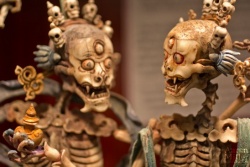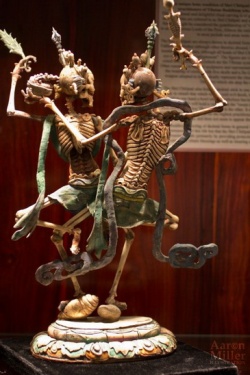Shri Chitipati
==Chitipati are The Lord and Lady of the Charnel Grounds.==
They are usually depicted as two skeletons, one a male and other a female. One is male and the other is female. The Citipati are one of the 75 forms of Mahakala and are visible reminders of the impermanence of everything worldly.
They are considered to be masters of the ceremony. One is male and the other is female. The Citipati are one of the 75 forms of Mahakala and are visible reminders of the impermanence of everything worldly. They are special protectors of Chakrasamvara and of the Dakini Vajrayogini.
Each holds a special sceptre, made of a death´s head with the spine still attached in its right and a skull bowl of blood containing brain in its left hand, while standing on the left leg a top a conch shell. Their mouths are parted in a large grin, showing all their teeth. The
figures stand in dance position with their legs intertwinded standing at a red sun disc and lotus blossom on a throne. They are surrounded by the red flames of pristine awareness.
In the cemetry, the Citipati are supposed to perform a skelleton ritual dance during which they blow the Tibetan long horns. In most monasteries the dance, symbolic of the cycle of life and death, is peformed in the monastery cemetry once in summer und once in winter by monks wearing masks.
According to a Tibetan legend, the two Citipatis were two ascetic monks in their former life. Deep in meditation, they did not realize that a thief cut off their heads and threw their bodies in the mud. They changed into wrathful death spirits, with vows of eternal vengeance. The skeletal
forms are referred to as Shri Chitipati and are Divine Beings whose major function might be considered the guardianship of “celestial burials” often referred to as the Glorious Lords of the Pyre. Almost the entirety of the Buddhist population in most periods and areas were cremated.
The Shri Chitipati are always shown in skeletal form and are generally considered a Father with Mother although other theories abound. Occasionally the heads take on leonine skeletal forms, although all heads of Shri Chitipati are shown with a “third eye of wisdom and enlightenment”. The figures are visually all shown dancing on
conch and courie shells (which are the Tibetan symbol of music) and embracing. Other constants in the few sculptures and representation of this known type include the wearing of crowns with five skulls and a Jin Gang Chu (an ancient Indian weapon adopted to symbolically represent the ritual implement for destroying Demons) which sits atop the crown.
The Shri Chitipati also holds a skeletal stick in one hand which symbolized the ability to smash that which would yield evil deeds, talk and thoughts. The Father will hold in one hand a bowl which symbolizes having taken control of the Devil’s blood. His Wife will hold a vessel with the “sweet dew of
wisdom” in her right hand and a protective “flower/grain” in the other. It appears this rendition and the few similar to it were made for the highest practitioners of Tibetan Buddhism who reside in Mongolia, and does not seem to appear there prior to the 18th century.

